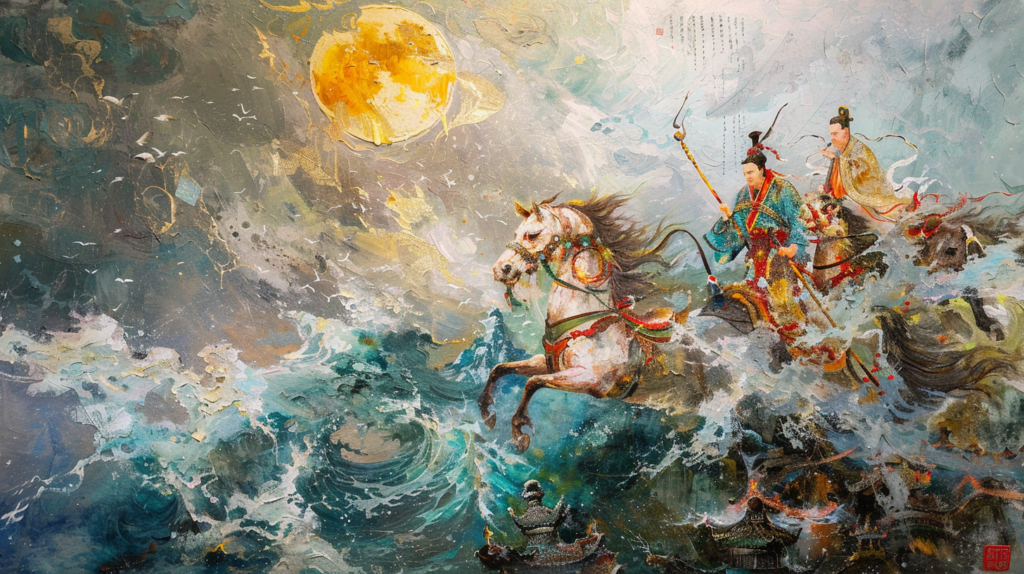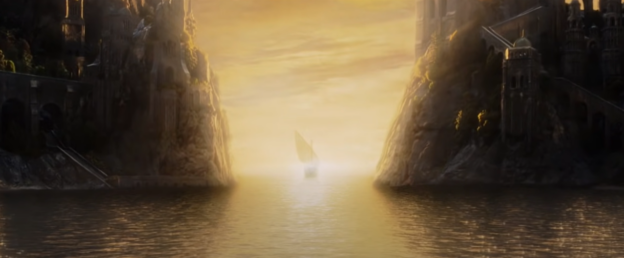This article delves into the concept of “The Western Lands” as an enduring myth across cultures and eras. Using William S. Burroughs’ The Western Lands as a springboard, it explores ancient mythologies, from Celtic voyages and Arthurian legends to Greek Elysium and Tolkien’s Undying Lands. Through these interpretations, the Western Lands emerge as symbols of humanity’s deepest longings for transcendence, ultimate peace, and the mysteries that lie beyond the known world.
Contents
- Introduction: A Kaleidoscope of the Fantastic and Mythic West
- Burroughs’ Western Lands: A Personal Journey into Mortality
- Celtic Western Lands: Lyonesse, Saint Brendan, and Mael Duin
- The Western Lands in Classical Mythology: Elysium and the Isles of the Blessed
- Tolkien’s Undying Lands: The West as a Realm of Transcendence
- Eastern Perspectives on the Western Lands
- Antiquities and the Western Lands
- Other Western Lands in Mythology and Literature
- The West as a Timeless Archetype: From Mortality to Mystery
- Conclusion: The Western Lands as Humanity’s Enduring Dream
Introduction: A Kaleidoscope of the Fantastic and Mythic West
The road to the western lands is by far the most heavily guarded and therefore most dangerous road in all the world.
W. S. Burroughs, The Western Lands
The concept of “The West” has captivated human imagination for millennia, existing as a distant realm of promise, mystery, and finality. In his novel The Western Lands, William S. Burroughs explores this mythic territory as a metaphorical endpoint, a place of transcendence, escape, and the ultimate journey. While Burroughs’ vision is rooted in modern existentialism, the Western Lands extend far back in human mythology. From the Celtic voyages of Saint Brendan and Mael Duin to the Arthurian kingdom of Lyonesse and the mystical landscapes of Tolkien’s Middle-earth, these “lands in the West” have served as metaphors for life’s ultimate frontier and humanity’s drive to explore beyond known realms.
In this article, we’ll delve into the ancient origins and symbolic meanings of the Western Lands, tracing how the concept of the West has evolved and recurred across literature, mythology, and philosophy.
This article was inspired by conversations with my son, Bill, during his degree course at the University of Birmingham in English Literature. It is the tenth of my “Myth of the West” cycle.
Burroughs’ Western Lands: A Personal Journey into Mortality
In The Western Lands, Burroughs uses the West as a place of ultimate passage, where the soul seeks release from the physical world. His West is a landscape of self-discovery and liberation from suffering, embodying the tension between endless potential and existential finality. By titling his work after this mythic destination, he aligns himself with a broader cultural tradition that views the West as a space of transformation and confrontation with the unknown, a transcendent space where human limits are tested and identities are dissolved.
Celtic Western Lands: Lyonesse, Saint Brendan, and Mael Duin
Celtic mythology is rich with stories of Western lands depicted as paradisiacal realms filled with magic, beauty, and eternal life. These mythical lands, often situated in the west, symbolize a place beyond the known world, reachable only by the bravest voyagers.
In Celtic mythology, the Sídhe (Fair Folk) are supernatural beings akin to elves, deeply tied to the land. According to legend, the Sídhe originally lived in harmony with humans but eventually retreated into the mounds, known as sídh, where they established hidden realms. After centuries of retreat, they are said to have ventured westward, seeking lands where they could live in eternal peace. Tolkien’s portrayal of the elves in The Lord of the Rings draws on this lore, depicting a wise, fading race retreating westward to a hidden realm free from the world’s sorrows.
The Tuatha Dé Danann, divine beings in Celtic lore, retreated westward after their defeat by the Milesians, journeying into mystical lands beyond mortal reach. In the Táin Bó Cúailnge, though there is no direct reference to a Western paradise, Cú Chulainn encounters spirits and mystical figures, hinting at a supernatural westward journey.
The legendary voyages of Saint Brendan and Mael Duin add to this tapestry. Saint Brendan, a sixth-century Irish monk, embarked on a legendary journey westward to find the “Promised Land of the Saints,” encountering strange islands, sea creatures, and paradisiacal lands along the way, a quest symbolizing the soul’s search for divine perfection. Similarly, in the Voyage of Mael Duin, the hero encounters enchanted islands representing stages of moral and spiritual testing, each offering unique challenges. This westward journey to Tir na nÓg (the land of eternal youth) influenced Western literature’s depiction of the “West” as a land where the limits of human understanding dissolve.
One of the most famous of these Western Lands is Lyonesse, an Arthurian paradise lost beneath the waves, said to lie west of Cornwall. Lyonesse reflects themes of loss and memory, symbolizing the unattainable perfection often ascribed to faraway lands.
The Western Lands in Classical Mythology: Elysium and the Isles of the Blessed
The concept of an afterlife in the West appears in classical mythology, where the Greeks imagined paradisiacal lands beyond the western edge of the world. Elysium was described as a paradise for heroes and virtuous souls, a realm of eternal peace, sunlight, and happiness. The Isles of the Blessed, also situated in the far west, were reserved for heroes who had completed lifetimes of virtuous acts, offering eternal life as a reward.
Another legendary Western Land is Atlantis, first mentioned by Plato in his dialogues Timaeus and Critias. Atlantis was an advanced civilization that lay west of the Pillars of Hercules, rich in culture and technology. However, due to the people’s pride, the gods destroyed Atlantis in “a single day and night of misfortune,” sinking it beneath the waves. This tale of Atlantis as a sunken paradise shares themes with other myths, like the lost city of Ys in Breton folklore and Lyonesse in Celtic legends. These sunken lands reflect humanity’s fascination with lost civilizations and serve as cautionary tales on human pride.
Tolkien’s Undying Lands: The West as a Realm of Transcendence
J.R.R. Tolkien’s Undying Lands in The Lord of the Rings reflect many Western myths, reimagining the West as a transcendent realm. The Undying Lands lie across the Great Sea, a place of beauty, healing, and immortality. In Tolkien’s world, the Undying Lands serve as a sanctuary for the weary, reserved for the Eldar (elves) and other blessed beings. The image of Frodo, Bilbo, and Gandalf sailing westward embodies Tolkien’s vision of the West as a paradise where suffering ends, aligning with myths like Elysium and Tir na nÓg.
Eastern Perspectives on the Western Lands
In Eastern mythology, the concept of the West symbolizes spiritual enlightenment and transcendent knowledge. In Chinese mythology, Journey to the West follows the monk Xuanzang and the Monkey King Sun Wukong as they journey to India, where the West represents sacred knowledge. This journey is both physical and spiritual, mirroring the Buddhist path to enlightenment.

In Pure Land Buddhism, the West is associated with the Pure Land of Amitabha Buddha, a transcendent realm where souls progress toward nirvana. Unlike a final paradise, the Pure Land is a realm of preparation, a symbolic space of transformation. Similarly, in Japanese culture, paradisiacal islands like Horai represent a state of unchanging beauty, aligning with ideals of natural harmony beyond mortal reach.
Antiquities and the Western Lands
Ancient cultures in Egypt, Persia, and Mesopotamia also share mythologies centred on the West. In Egyptian belief, the West symbolized the afterlife. Known as the Land of the Setting Sun, the West was associated with Duat, where souls journeyed through a landscape of trials overseen by Osiris, eventually reaching the Field of Reeds, a paradise for those who passed judgment.
In Zoroastrian Persian belief, the West represents realms of light and wisdom. Souls journey westward toward Garōdman, or the House of Song, symbolizing cosmic balance and enlightenment. In Mesopotamian mythology, the West was a boundary to the underworld, where the sun god Shamash descended, marking life’s cycle.
The Greek Garden of the Hesperides similarly lay at the western edge, guarded by nymphs and filled with golden apples of immortality, symbolizing an unreachable paradise.
Other Western Lands in Mythology and Literature
Australian Indigenous Perspectives emphasize the symbolism of the Western horizon within Dreamtime narratives. Here, the setting sun signifies life cycles and the transition to the spirit world, where ancestral spirits dwell.
In South American Andean cultures, the West signifies the journey of the soul. For the Inca, the western horizon is sacred, representing the land of ancestors, while Amazonian groups often see the West as a realm of spirits, blending life cycles with spiritual realms.
Inuit beliefs associate the West with ancestral journeys. In these Arctic cultures, the Western journey connects the soul with the natural world, where animals carry ancestral spirits across realms. The West thus becomes both a destination and a bridge between life and the afterlife.
In African mythology, the West often serves as a spiritual threshold. In Yoruba and Dogon beliefs, the West marks the transition to the ancestors’ world, emphasizing continuity and cycles, rather than finality, in the afterlife.
In Arabian and Persian folklore, the West is linked to realms of mystical knowledge. In the 1001 Nights, tales of Western journeys often lead to lands of magical creatures, symbolizing the West as a place of hidden knowledge and divine encounter.
In Russian folklore, the West often represents mystery and transformation. Lands of magic and trials, such as those ruled by Koschei the Deathless or Baba Yaga, reside in the West, where heroes face trials that test their strength and courage.
The West as a Timeless Archetype: From Mortality to Mystery
In examining these interpretations of the Western Lands, a shared symbolic core emerges: the West as a metaphor for human transcendence and the ultimate destination. Across cultures and eras, these stories reflect our desire to escape mortality and suffering, casting the West as a place of beauty, mystery, or eternal peace.
The archetype of the West is timeless, embodying both fear and hope. It is a place humanity seeks, yet remains just out of reach. In The Western Lands, Burroughs imagines it as a realm of ultimate freedom; for Tolkien, it is a place of rest. Across mythologies, the West becomes a universal symbol for humanity’s journey toward meaning, completion, and the unknown.
Conclusion: The Western Lands as Humanity’s Enduring Dream
The myth of the Western Lands interweaves threads from mythology, literature, and spirituality, reflecting a universal longing for places where earthly struggles end and enlightenment begins. Whether Avalon, Elysium, Tir na nÓg, or the Undying Lands, the Western Lands represent an enduring dream of escape, transcendence, and ultimate peace.
In today’s world, the allure of these lands is potent as we grapple with existential questions. The Western Lands are not merely literary constructs; they embody humanity’s collective hope for a place where limitations fall away and ultimate truths are revealed. They reflect our timeless journey to the edges of knowledge and existence, where the known gives way to the unknown.
The Western Lands resonate because they are not only about physical destinations but also metaphysical spaces we seek in our own lives, places where we find resolution, peace, and perhaps, transcendence. They are a testament to humanity’s quest for meaning, casting the West not just as a direction but as a symbol of final answers, beckoning us forward into the mystery that defines the human spirit.
